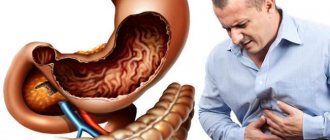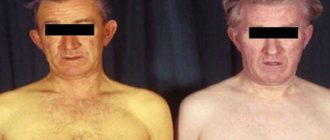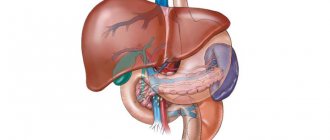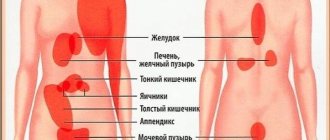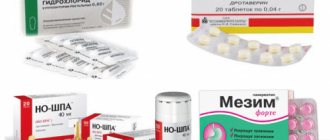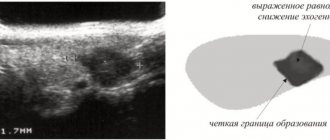Pain in the ribs or under the ribs often forces people to seek help from doctors of various specialties, since it imitates angina pectoris, pleural pain, and the consequences of injury. But often pain in the ribs is a consequence of problems with the spine.
Doctors at the Osteomed Clinic in St. Petersburg very often observe in their practice patients with pain in the ribs or intercostal neuralgia. Along with the pain syndrome, other manifestations are also identified in patients, which require detailed consideration and exclusion of other pathologies. To do this, you need to make an appointment with an experienced specialist and undergo a full examination.
Possible causes of rib pain
Most often, patients believe that pain occurs in the rib bones, although in fact the discomfort may appear due to muscle spasms or compression of the nerve roots. Main reasons
rib pain:
- pathologies of nerves and muscles;
- excessive physical and psychological stress;
- trauma, rib tumors, Tietze syndrome;
- diseases of the spine (spondylosis, arthrosis, osteochondrosis, hernias and protrusions);
- pathologies of the pleura, including tumors.
Soreness of the rib bones is a relatively rare phenomenon that occurs in severe bone diseases or injuries (fractures). If pain in the ribs appears after a bruise or fall, or a blow to this area, medical attention is required immediately, because a broken rib bone can damage the heart or lungs.
Often discomfort in the chest area accompanies colds or pneumonia. This symptom should be reported to your doctor, as it can be not only muscle spasms due to coughing, but also the consequences of deterioration of the lungs, bronchi or pleura.
Features of pain in various ailments
In case of pain in the hypochondrium, which intensifies when pressed and is accompanied by an increase in temperature, you need to call an ambulance. Unpleasant sensations can be caused by inflammation of the gallbladder, diseases of the intestines, liver and kidneys. With these disorders, the pain is often reflected or “smeared,” which may make it seem as if its source is the ribs. With Tietze syndrome, a non-infectious inflammatory process occurs in the costal cartilages. It is characterized by pain that increases with pressure or inhalation. Another dangerous condition, fibromyalgia, is accompanied by damage to soft tissues, which causes severe pain when touched and pressed. This pathology is characterized by morning swelling of the limbs. Often, discomfort is caused by excessive muscle tension. This problem also requires medical consultation, because it can occur with severe pathologies of the spine or neuralgia. How to distinguish neuralgia from osteochondrosis:
- with osteochondrosis, the pain is constant, with neuralgia, unbearable sharp pain in the ribs periodically occurs;
- Osteochondrosis is characterized by overstrain of the back muscles;
- in the case of neuralgia, pain intensifies with pressure.
Other signs may indicate that pain in the costal region is caused by pathologies of the spine:
- frequent dizziness;
- decreased back mobility;
- impaired sensitivity of the limbs;
- a feeling of “current” in the body when moving;
- crunching, crackling when turning and tilting the body;
- numbness in the chest, back, buttocks, arms;
- pressure surges.
The cause of pain in the ribs may also lie in spinal deformation. With lordosis, kyphosis and scoliosis, the entire “axis” of the body is disrupted, which causes internal organs and joints to shift, the static load to be incorrectly distributed, and constant muscle tension occurs. What you can do before seeing a doctor if your ribs hurt:
- take a pain reliever;
- wear loose clothing that does not compress the chest;
- lie down;
- try to breathe slowly and smoothly.
Organs located on the right side
The following organs are located on the right side of the body:
- liver;
- gallbladder;
- diaphragm (its right side);
- pancreas;
- appendix;
- right kidney;
- intestine (part of it).
A burning sensation on the right side in front often indicates the development of biliary dyskinesia. If the patient often engages in heavy physical activity, then such a symptom will also not take long to appear. A burning sensation on the right under the ribs when eating a large amount of peppery, spicy and fatty foods increases the load on the gastrointestinal tract. It provokes the development of gastritis, stagnation of secretory fluid in the gallbladder.
If the disease is not treated in time, the bile begins to crystallize and leads to the formation of stones. It can be concluded that all organs of the gastrointestinal tract can become involved in the development of inflammation. Neuralgia and a large accumulation of salt deposits can also cause a burning sensation not only under the ribs, but also in the lumbar region.
In the event that the burning sensation spreads to areas where the liver and gallbladder are located, specialists urgently prescribe a series of diagnostic procedures. The main method used is ultrasound of the abdominal cavity, CT, MRI, and study of the condition of appendicitis through palpation and the gastrointestinal tract.
Liver and gallbladder
The most important functions of the liver are to neutralize the effects of toxic substances, cleanse the blood of harmful impurities and produce bile necessary for the breakdown of fats in the intestines. Considering the stress that this organ experiences due to its multitasking, it is often attacked by various diseases.
The gallbladder is a small muscular sac that stores bile. The organ is located directly below the liver. Through the bile duct it transports secretory fluid to the duodenum, where it takes part in the digestive process.
Hepatic and biliary pathologies often occur against the background of the following processes:
- eating fried, fatty and salty foods;
- alcohol abuse;
- the presence of inflammatory processes in the digestive system;
- helminthic infestation.
Constant stress can also provoke disruptions in the functioning of these organs.
Table 1. Diseases of the liver and gall bladder
| Disease | Description |
| Impaired flow of bile. | Dyskinesia, characterized by decreased motility, leads to stagnation of bile. The patient experiences prolonged pain and burning in the right side. The pain may radiate to the anterior part of the peritoneum and spread to the lumbar region. Deterioration of the condition is observed with excessive nervous or physical stress. Sometimes symptoms worsen after taking spicy or fatty foods and a number of medications. The danger of this disease lies in the crystallization of the secretory substance, leading to the formation of stones. |
| Cholelithiasis. | When stones form in the ducts, acute colic, caused by a slowdown in the release of secretions, is added to the burning sensation. |
| Cholecystitis. | In most situations, inflammation of the walls of the gallbladder occurs against a background of increased acidity, causing heartburn and frequent bouts of nausea. This pathology negatively affects the general physical condition and contributes to a decrease in working capacity. If pain in the right shoulder blade or shoulders is added to the burning sensation, the disease has become acute. |
| Hepatitis and cirrhosis. | In the presence of these diseases, pronounced pain is not always observed. However, in the acute form of the pathology, a strong burning sensation appears in the right hypochondrium. The destruction of liver tissue is often painless, sometimes revealing itself through yellowing of the skin. |
Often, liver diseases, especially cirrhosis, lead to death. Pathologies of the gallbladder in the final stages of development are treated using surgical intervention. Therefore, it is so important to identify the disease at an early stage and take the necessary measures in a timely manner.
Pancreas and intestines
The pancreas is a large gland that performs 2 important functions in the body. It produces pancreatic juice, which contains a large amount of enzymes necessary for the digestive process. In addition, it produces insulin and glucagon, which regulate metabolic processes.
The intestine is the largest organ of the gastrointestinal tract and belongs simultaneously to two systems - digestive and immune. It is a protective barrier that prevents attacks from pathogenic bacteria, and processes fats and carbohydrates found in the food bolus.
Pain and burning sensation in the right side of the peritoneum may indicate the following diseases.
Table 2. Diseases of the pancreas and intestines
| Disease | Description |
| Pancreatitis. | An inflammatory process affecting the pancreas. Pathology occurs due to a violation of the outflow of digestive juice. Having settled inside the gland, the enzymes in the liquid begin to digest the surrounding tissue. In the acute form of the pathology, neighboring organs and blood vessels are destroyed. In especially severe cases, a necrotic process begins, leading to death. |
| Duodenal ulcer. | A defect in the walls of this section of the intestine occurs due to the effect of acid on the mucous membrane. Unlike erosions, an ulcer leaves a scar after healing. The pathology is accompanied by a feeling of heat after eating and a characteristic burning sensation in the right side. |
If the pain goes lower, you should check the condition of the appendix.
Kidneys
The paired organ is localized in the lower part of the body - in the lumbar region. In some cases, kidney pathologies are accompanied by pain that radiates to the right hypochondrium, groin and other parts of the body. Such disorders can manifest themselves against the background of the presence of stones, which are formed due to a sedentary lifestyle and the presence of metabolic disorders. In addition to unpleasant painful sensations, if there are kidney stones, the patient complains of surges in blood pressure, vomiting, and nausea.
Typically, kidney disease causes colic, but between attacks of pain, a burning sensation may occur under the right or left rib. The localization of the unpleasant sensation depends on the location of the affected kidney. Associated symptoms of pyelonephritis are chills, sweating, headache, nausea, diarrhea, and lack of appetite. When kidney stones appear, a burning sensation will occur in the lower back and sides. Discomfort will increase with bending and other movements.
Table 3. The most common kidney pathologies
| Disease | Description |
| Urolithiasis. | Formation of stones in the urinary tract, which are formed against the background of: • diseases of the thyroid gland, • abnormalities of the genitourinary system; •metabolic disorders. In people with a sedentary lifestyle, they appear due to stagnation of urine in the kidneys. In the presence of large stones, aching pain is noted in the lumbar area, radiating to the hypochondrium. Small pebbles cause sharp, sharp pain that radiates to the side. In addition, a burning sensation, vomiting and increased blood pressure are noted. |
| Pyelonephritis | A possible complication of urolithiasis, causing inflammation of the kidney. It also appears as a result of an attack by harmful bacteria. It often occurs without pronounced symptoms. The burning sensation in the hypochondrium may be weak and almost unnoticeable. |
As a rule, kidney diseases manifest themselves through back pain, only occasionally radiating to the hypochondrium area.
Lungs
Pathologies of the respiratory system are rarely accompanied by pain in the upper right part of the abdomen. The appearance of pressing, aching or other unpleasant sensations in this area is possible with the development of pleurisy. The disease is characterized by inflammation of the serous membrane that envelops the lungs and the accumulation of fluid in it. Pleurisy is manifested by pain in the sternum, shortness of breath, cough, chills, general weakness, and increased body temperature.
What other reasons could there be?
Dull or sharp pain under the rib can be caused by other diseases:
- shingles;
- myocardial infarction;
- intercostal neuralgia;
- giardiasis;
- osteochondrosis.
Pain in the right hypochondrium can occur during pregnancy due to the pressure that the fetus puts on the gallbladder. Discomfort also occurs after intense physical activity, during menstruation in women. It is short-term in nature and does not interfere with human life.
Carrying a baby to term can also cause discomfort. This is due to the pressure that the fetus puts on the gallbladder.
Diagnosis for rib pain
Attempts at self-medication can lead to serious consequences, including death. Remember: the sooner you receive medical advice and begin treatment, the lower the price of treatment and the higher its effectiveness. You can contact for help:
- therapist;
- phthisiatrician (if there is a cough, hemoptysis, difficulty breathing, suffocation);
- neurologist, orthopedist (for numbness in the hands, crunching when moving, back pain);
- traumatologist (for bruises, falls and other injuries).
To make a diagnosis, the doctor needs not only a survey of the patient and his examination, but also data from laboratory tests and instrumental studies:
- ECG;
- radiography;
- MRI, CT;
- blood and urine tests;
- and other types of examination.
Treatment for rib pain
The treatment plan is developed depending on the diagnosis and the reasons for the development of the pathology. For the treatment of cervicothoracic osteochondrosis and other pathologies of the spine and joints, anti-inflammatory and painkillers, antispasmodics, chondroprotectors and muscle relaxants are prescribed. Courses of massage, physiotherapy, manual therapy or osteopathy may also be prescribed.
Massage helps relieve excessive tension and pain, it has a warming and relaxing effect. However, this procedure is unacceptable for acute injuries, colds and cancer.
Physiotherapy and acupuncture help eliminate pain and muscle hypertonicity, normalize metabolic processes, eliminate inflammatory foci, restore damaged tissue and increase local immunity. To strengthen the muscle corset and healthy distribution of static load, physical therapy is necessary, which allows you to relieve spasms, increase muscle mass and correct posture. During treatment and in the future for prevention, it is necessary to follow a daily routine and get enough rest, wear comfortable shoes, avoid hypothermia and eat right.
Treatment of pain under the ribs
As a rule, in case of severe pain, the doctor uses various painkillers - they can be taken in the form of tablets or administered parenterally. Unbearable pain, which can also occur with intercostal neuralgia, is relieved by novocaine blockade in the area of compression of the nerve roots.
Each identified pathology has its own specific means for treatment. In vertebrology, chest pain caused by thoracic or cervicothoracic osteochondrosis has its own treatment features:
- Drug treatment includes analgesics, anti-inflammatory drugs, muscle relaxants, mild diuretics, drugs to improve peripheral circulation, chondroprotectors, vitamin and mineral complexes;
- Manual therapy, therapeutic exercises, physiotherapy act directly on the causative factor of the pathology, helping to release muscle-joint blocks, strengthen and develop the muscles around the spine, improve blood supply and trophism of the thoracic spine;
- Other types of treatment include prescribing rest during the acute period, a diet with a predominance of proteins, dairy products, vegetables, fruits with the exclusion of grapes, sorrel, coffee, carbonated drinks, sweets, and fatty foods from the diet. In addition, patients can use acupuncture, stone therapy and other methods in complex treatment.



